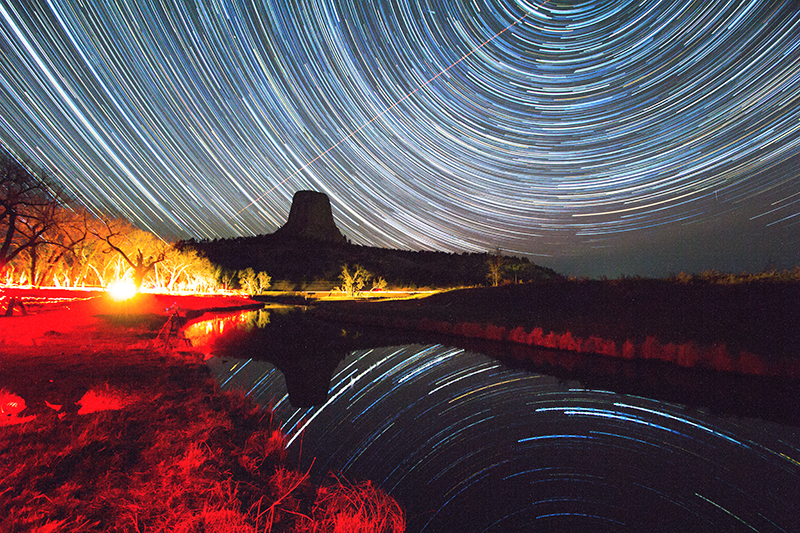First, thanks to Rick for asking me to do this guest blog post. I've been on several workshops with Rick and I have to say, they are a great learning experience and a ton of fun. What's more, you meet great people!
Rick asked me to write this guest blog post because I, along with Mike "Spike" Ince, will be leading the nighttime photo session on Rick's Southwest Photo Caravan later this year. (Note from Rick: All my 2013 workshops are full, but space is available on my 2014 workshops.)
I’m going to be outlining the basic steps to creating a simple timelapse video using Adobe Lightroom 4 with a bit of help from LRTimelapse.
If you’ve seen any of the incredible night-sky timelapse videos on the web and wonder how they do it, the good news is that the basic process isn’t that hard. The main steps are:
1) Create a sequence of photos.
2) Process them as desired in Lightroom, using Auto-Sync to make sure all the photos are adjusted the same.
4) Export the entire sequence as a Lightroom Slideshow video using some slideshow and video export presets from LRTimelapse.
In my case, after catching the night photography bug at the VLA during last year’s Bosque Del Apache workshop with Rick and Juan Pons, I attended a night photography workshop at Devil’s Tower with Colorado night-photography instructor David Kingham. While it wasn’t specifically a time-lapse workshop, I was left with several hours-long sequences of photos and he recommended I look into LRTimelapse for creating time-lapse videos.
Above (click here to watch): The Milky Way over Devil’s Tower with the lights of Hulett, Wyoming over the horizon.
LRTimelapse is available at LRTimelapse.com. There’s a full paid edition, but the free edition will do quite a bit to start. The software allows you to deflicker your photos and do adjustments across the entire sequence, but for this simple example, I only had to use the export presets that come along with the software. Download and install the software, paying specific attention to getting the included Slideshow and Video presets installed.
As far as the photos themselves, obviously you’ll need a tripod and an intervalometer. I’ll skip over the those details for this post and just talk about creating the video, but you can check Mike (Spike) Ince’s prior guest post on night photography. My night photos were all 30-second exposures with one second between. Because the light was consistent across the sequence and I was in manual exposure mode, I didn’t get any flicker that might need to be adjusted.
Above (click here to watch): A wider, fisheye view with more metors.
After you import all your photos into an individual directory in Lightroom, you can make whatever adjustments you need to get them looking how you want. Use Lightroom’s Auto-Sync feature to apply the adjustments consistently across the entire batch of photos. Or, another option is to edit one of the sequence as desired, then cut and paste the Lightroom adjustments to the rest of the photos.
After you’ve gotten your sequence edited, the next step is go into the Lightroom Slideshow module and select your entire sequence of photos. Use one of the LRTimelapse presets - they will set you up for a clean video sequence. For mine, I used the 15-fps 1080p preset from LRTimelapse. Then I just used the 1080p setting for the video export. When your export is done, you will have an mp4 file you can then play or upload to Youtube or Vimeo.
That’s really all I did here. It’s simple, but gave me enough of a start to want to learn and do more. Further steps include using LRTimelapse to handle the flicker you can get from auto-exposure adjusting to changing light levels, or day-to-night transitions (like the moonrise at the end of these videos). Then there’s adding music, editing multiple sequences together, etc.
Above (click here to watch): Devil’s Tower Creek Reflection with Star Trails, Light Painting, and Wandering Photographers
I’ll leave you with a couple of observations. First, it takes a lot of photos to generate a short sequence - at 15 frames per second, 2 hours of images generates only 16 seconds of video. And second, both night photography and timelapse are extremely addictive. know! I’m going to be doing many more.
Good luck trying this on your own!
Thanks again Rick! I look forward to our Southwest Photo Caravan.
David Kingham Photography
Spike's Guest Blog Post on Night Photography
Andy Smith on Google+
Andy Smith Photo Website




